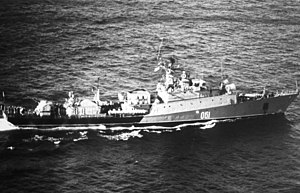 Grisha I-class corvette
| |
| Class overview | |
|---|---|
| Name | Grisha class |
| Builders | Zelenodolsk Gorky Plant (340), Zelenodolsk; Leninska Kuznya (302), Kiev; Kirov Shipyard (876), Khabarovsk; Eastern Shipyard (602), Vladivostok |
| Operators |
|
| Succeeded by | |
| Planned | 92 |
| Completed | 86 |
| Cancelled | 6 |
| Active | 19 in Russian Navy as of 2023 (7 Pacific, 6 Northern, 6 Black Sea) |
| Retired | 67 |
| General characteristics | |
| Type | Anti-submarine corvette |
| Displacement | |
| Length | 71.6 m (235 ft) |
| Beam | 9.8 m (32 ft) |
| Draught | 3.7 m (12 ft) |
| Propulsion |
|
| Speed | 34 knots (63 km/h; 39 mph) |
| Range | 4,000 nautical miles (7,400 km; 4,600 mi) at 10 kn (19 km/h; 12 mph) |
| Complement | 60 |
| Sensors and processing systems |
|
| Electronic warfare & decoys | Bizan-4B suite with Watch Dog intercept |
| Armament |
|
The Grisha class, Soviet designation Project 1124 Al'batros, are a series of anti-submarine corvettes built by the Soviet Union between 1970 and 1990 and later by Russia and Ukraine. These ships have a limited range and are largely used only in coastal waters. They have been equipped with a variety of ASW weapons and an SA-N-4 'Gecko' surface-to-air missile launcher. All were fitted with retractable fin stabilizers.
The designation "corvette" for these ships was a conditional adaptation as the Soviet classification was a small anti-submarine ship (Russian: Малый противолодочный корабль, romanized: Malyy protivolodochnyy korabl, lit. 'Small anti-submarine ship') (MPK). In the Russian Navy, the Grishas are expected to be partially replaced by the Steregushchiy-class corvette.
- ^ a b "Project 1124 Specifications". GlobalSecurity.org. Retrieved 28 November 2018.